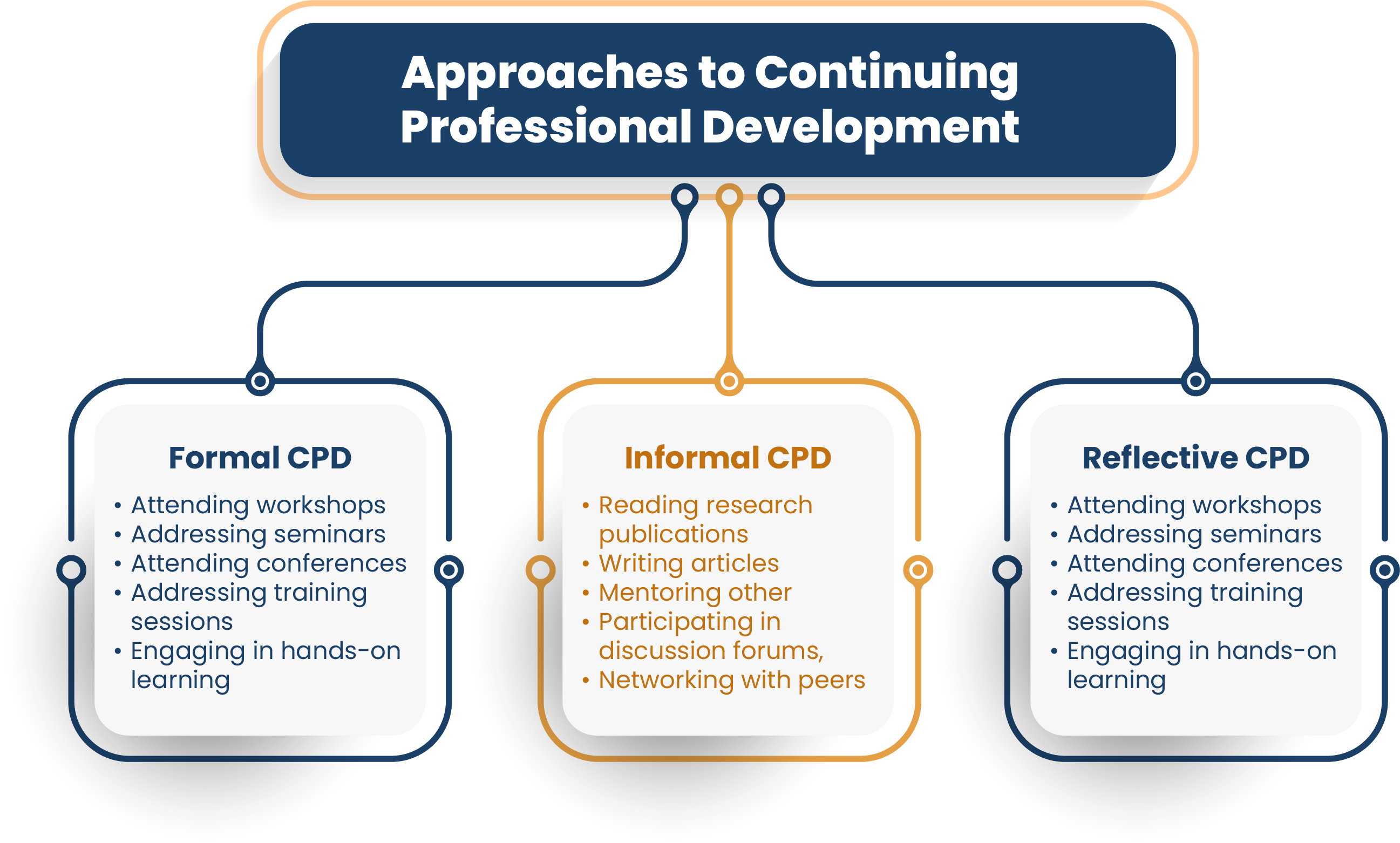Continuing Professional Development (CPD) allows you to stay ahead in your field, and staying ahead requires more than just a degree or a qualification.
Stick with us, as this guide encompasses all the information on CPD: who offers it, what its types are, who can benefit from CPD, and much more!

Definition of Continuing Professional Development
Continuing Professional Development (CPD) refers to the ongoing learning and development process that enables professionals to stay current and relevant in their fields. It supports individuals in continuously enhancing their skills and knowledge, ensuring they are well-equipped to progress and excel throughout their careers.

Why Professional Development is Important?
Continuing Professional Development is important in helping professionals adapt to a rapidly changing business environment, including advancements in technology and industry practices.
A good example would be technological advancements like automation and Artificial Intelligence (AI) which are constantly reshaping job roles and the skills required.
As these changes occur at a fast pace, professionals must engage in ongoing development to stay current, competitive, and capable of meeting new challenges. Following benefits evidence that, it is a great way to grow and excel in your career:
Quickly Adapt to the Market Demands
In today’s competitive job market, the efficiency of task completion continues to improve with advancements in technology and research, making ongoing learning essential for professionals.
For example, healthcare professionals are regularly presented with technological advancements, latest research, studies and information regarding new treatments and diagnostic techniques in patient care.
They can keep themselves up to date with the latest advancements and sharpen their skills in the field by participating in relevant CPD to provide better patient care and health.
Maximise Career Progression Opportunities
Participating in CPD activities is a great tool through which professionals can expand their skill set and acquire roles like leaders or managers. Not only do chances of their promotion increase but they become a great asset to the company as well.
Stand out from other Applicants
Employers seek candidates with a diverse skill set gained through experience and ongoing learning. Incorporating relevant CPD activities into once resume demonstrates their dedication and commitment to staying current in their field.
For instance, if they participated in a CPD course on project management methodologies, they could mention it briefly in their CV. This shows that they successfully managed a project and improved its efficiency and employers will be more likely to notice them because of this.
Leverage CPD Events to Network with Other Professionals
Professionals can participate in CPD events to network with relevant peers from diverse fields. Many CPD training providers organise conferences or seminars that offer a great opportunity to build relationships and share ideas.
What are Alternative Terms of Continuing Professional Development (CPD)?
Continuing Professional Development (CPD) goes by many terms including Continuing Education (CE), Continuous Professional Education (CPE), Professional Development (PD), professional learning, continuous training, continuous learning, ongoing learning, professional skills enhancement, workplace development, career advancement and more.
How Does CPD Benefit Employees and Employers?
CPD is extremely beneficial for both employees and employers. It can be viewed as an investment to enhance their knowledge and skills and maintain their workplace standards.
CPD for Employees
- Employees can fill their learning gaps by increasing their knowledge and polishing their skills, to keep themselves up-to-date with the latest advancements and developments in their industry.
- Participating in CPD training can help improve confidence and develop better communication skills.
- Employees can mention their CPD certification on their CV; ultimately helping them find new and better job roles.
CPD for Employers
- By initiating CPD in the organisation, employers can make sure their staff is trained and remains consistent with their company standards.
- Investing in employee development ensures employees remain loyal and connected with them for a longer time.
- By investing in employee development employers can stand out in the competitive market with a better workforce that will ultimately provide better products or services.
Common Misconceptions: Continuing vs. Continuous Professional Development
Even though the terms continuing and continuous are often used interchangeably as if they mean the same thing, they have slightly different meanings.
Continuing Professional Development is more structured, whereas Continuous implies uninterrupted, informal learning.

Who Can Benefit from Continuing Professional Development (CPD)?
Continuing Professional Development is for a range of professionals across many industries. Whether for corporate leaders, IT professionals, educators or healthcare practitioners, CPD provides ongoing learning, career advancement, and skill refinement all while maintaining professional relevance.
For instance, for healthcare professionals, CPD may involve attending hands-on clinical workshops, seminars, simulation-based training etc.
How Can You Access Continuing Professional Development Programmes?
One can access multiple CPD programmes via different organisations and institutions. These include trainers and industry specialists who design and deliver CPD themselves or training providers like universities that offer accredited CPD courses that meet quality standards and regulation framework.

Are There Any Requirements for CPD in Different Professions?
Yes, there are different CPD requirements across various professions and industries, and they also vary significantly according to region.
Regulated professionals, such as architects, healthcare professionals (including doctors, nurses, and medical practitioners), and legal professionals are required to participate in activities like conferences and courses to earn CPD credits and stay up to date with the latest developments in their fields.
For instance, in the UK, architects are required to complete Continuing Professional Development (CPD) to stay registered with the Architects Registration Board (ARB). While the ARB doesn’t specify exact CPD hours, architects must demonstrate engagement in learning activities relevant to their practice. They are encouraged to maintain a professional development record and show how their CPD activities improve their skills and competency.
Does CPD Count as Qualification?
No, CPD does not count as a qualification but rather a tool to achieve a qualification. CPD certifications enhance your qualifications but are not standalone degrees. Anyone can earn a professional development certificate by participating in activities like seminars, workshops or online courses.
Can I Get a Job with a CPD Certificate?
Yes, many CPD training providers help organise conferences or seminars which offer a great opportunity for professionals to meet, build relationships, and share ideas.
Learn more about how CPD certificates can improve your job prospects.
What are the Approaches to Continuing Professional Development?
There are 3 main approaches to Continuing Professional Development, which cover a range of CPD activities and different ways to participate in them:

Formal CPD
Formal CPD, also known as active or structured CPD, involves interactive learning activities designed by educational institutions or professional bodies. These activities, including courses, workshops, and seminars, are aimed at achieving specific learning outcomes and require participants to engage and collaborate with others. This structured approach enhances relevant skills and knowledge, ensuring compliance with industry standards and improving career prospects.
Examples include, but are not limited to:
- Attending structured workshops, seminars or conferences
- Participating in formal learning or training within your organisation
- Addressing seminars or lecturing other trainers
- Engaging in hands-on learning by participating in relevant workshops
These activities often lead to credits, qualifications, certifications, or credits.
Informal CPD
- Reading journals, research papers or other professional publications, either online or offline
- Writing articles for your self-development
- Mentoring other learners or trainers
- Participating in discussion groups or online forums
- Networking with peers
Reflective CPD
Reflective CPD involves analysing and evaluating our own professional experiences to enhance practice. It helps individuals understand their learning outcomes, identify areas for improvement, and boost overall effectiveness.
The examples may include:
- Keeping a learning journal or portfolio
- Attending mentoring or coaching sessions
- Participating in peer review or supervision
How to Show Evidence of Continuing Professional Development?

You can show evidence of your Continuing Professional Development via different means, such as:
- CPD Log:
It serves as a detailed account of your professional development efforts. Record descriptions, dates, learning outcomes, and reflections of all CPD activities in your CPD Log.
- CPD Certifications and Documents:
Keep certificates of completion, attendance records, and any official documentation from courses, workshops, seminars, or training sessions.
- CPD Portfolio:
Compile a portfolio showcasing your CPD activities. Include summaries of learning experiences, evidence of practical application, and feedback from peers or mentors.
- Reflective Statements:
Include reflective statements on how each CPD activity has impacted your professional practice and contributed to your growth.
- CPD Plan:
You can also write a CPD plan, demonstrating how you planned and achieved your learning goals.
These methods collectively offer a robust way to demonstrate and substantiate your ongoing commitment to professional development.
How Can You Record Your CPD?
There are multiple ways to record your CPD. It is highly crucial for any professional regardless of their industry to track their ongoing learning and activities.
Here is how you can record your CPD step by step:
- Before recording CPD, understand the requirements and make sure you know how many CPD hours or credits are required.
- Select the method to record your CPD. it can be a spreadsheet, CPD management software, or any other offline or online digital platform.
- Document all your CPD activities like attending workshops, conferences, and training sessions including their date, duration, type, and learning outcome.
- Next, classify your CPD activities into relevant categories according to your professional requirements. These categories may include formal learning, informal learning, reflective practice, or professional practice.
- Keep any supporting evidence, such as certificates, and reflective journals, as proof of completion for your CPD activities.
- Regularly track your progress, and assess your learning journey by calculating Return On Investment (ROI) to ensure you align with your goals and development plan.
You can effectively record your CPD activities and show your dedication and devotion to ongoing professional development.
How many stages are in the CPD Cycle, and What's its Main Goal?
There are 7 stages of CPD cycle which are:
- Identification- Identify the learning needs.
- Planning – Develop a plan to address the needs
- Action – Implement the plan.
- Recording – Keep a record of activities.
- Reflection – Reflect on what you have learned.
- Evaluation – Evaluate the effectiveness and impact of CPD activity.
- Application and sharing – Apply the skill learned in your professional practice and share your insight with others.
The main goal of the CPD Cycle is to provide a structured approach for professionals to manage their ongoing development, measure their progress, and ensure that their learning is effectively applied to improve their practice and achieve career growth.
Is CPD Expensive?
No, CPD is generally not expensive compared to formal qualifications. However, costs can vary based on several factors:
- Conferences and workshops are more expensive than online courses based on course type and length.
- The cost may also vary on provider accreditation as reputable providers with accreditation may charge more.
However, there are affordable CPD options as well; you can find professional organisations that offer free articles or webinars, or there may be some employers that offer their own CPD programmes.

Conclusion
To sum up, Continuing Professional Development (CPD) is a vital and helpful tool for almost all professionals to stay relevant and competitive in their fields. Engaging in CPD activities allows individuals to enhance their skills, knowledge, and understanding of their industry, which can lead to career advancement and new opportunities. For employers, CPD ensures a skilled and qualified workforce. Moreover, there are various affordable CPD options available. Professionals need to maintain a record of these activities to demonstrate their commitment to professional development.
























